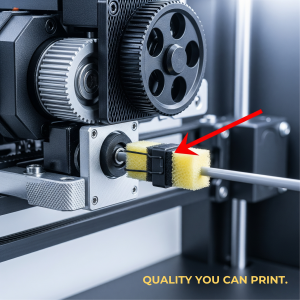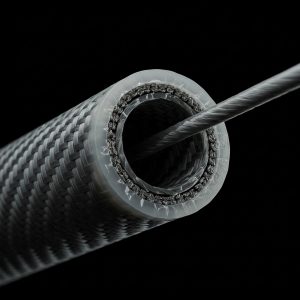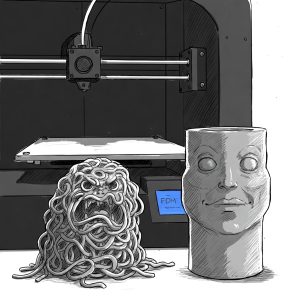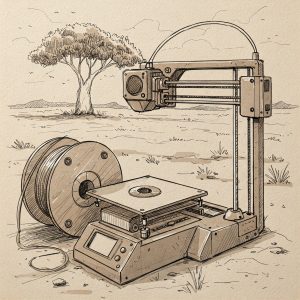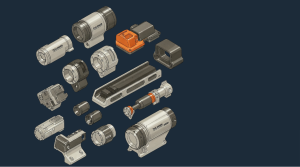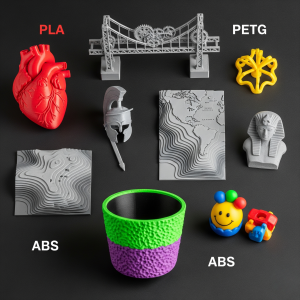
N.E Print Shop
Hack Your Health: How 3D Printers Are Powering the Biohacking Revolution
NE Print Shop
N.E Print Shop
NE Print Shop

You track your steps, monitor your sleep, and maybe even log your calories. You’re already collecting data to understand and improve your body. But what if you could take it a step further? What if you could build the exact tools you need to conduct your own health experiments, right from your desktop?
Welcome to the world of biohacking. It’s not about becoming a cyborg (at least, not yet for most). At its core, biohacking is the art and science of making incremental changes to your lifestyle to improve your health and well-being. It’s about applying the hacker ethos to your own biology – a DIY approach to optimizing your body and mind.
And what’s the ultimate tool for any DIY enthusiast, hacker, or innovator? The 3D printer.
This isn’t a sales pitch. This is an exploration of a fascinating and rapidly growing subculture where the humble spool of filament is becoming as crucial as a petri dish. At NE3D Printing, we’re passionate about the limitless potential of 3D printing, and this is one of the most exciting frontiers we’ve seen.
For decades, cutting-edge scientific research has been the domain of well-funded universities and corporations. The equipment is expensive, often proprietary, and inaccessible to the average person. But biohacking is changing that. A growing movement of “garage biologists” and citizen scientists are setting up home labs to explore everything from genetics to personalized nutrition.
The biggest hurdle for these DIY scientists has always been the cost of equipment. A simple test tube rack can be surprisingly pricey, and more complex tools like centrifuges or micropipettes can run into the thousands. This is where the synergy with 3D printing becomes so powerful.
With a 3D printer and a bit of design know-how, a biohacker can create a vast array of custom lab equipment for a fraction of the cost of traditional supplies. We’re talking about printing:
Custom-designed test tube racks and holders for specific experiments.
Microscope adapters for smartphones, turning a simple device into a powerful imaging tool.
Small-scale centrifuges for separating liquids.
Electrophoresis chambers for analyzing DNA.
Micropipettes for handling precise volumes of liquid.
The open-source nature of the 3D printing community means that designs for these tools are often shared freely online. Platforms like Thingiverse and Open-Labware.net are treasure troves of printable scientific equipment, allowing anyone to download, modify, and print the tools they need. This isn’t just about saving money; it’s about empowerment. It’s about breaking down the barriers to scientific exploration and putting the power of discovery into the hands of individuals.
The real game-changer in the intersection of biohacking and 3D printing is the power of personalization. Your body is unique, and the one-size-fits-all approach to health is becoming increasingly outdated. Biohackers are at the forefront of this personalized health revolution, and 3D printing is the perfect technology to support it.
Consider the burgeoning field of personalized nutrition. With the rise of affordable genetic testing, it’s now possible to gain insights into how your specific genetic makeup influences your dietary needs. Imagine a future where you can 3D print your daily supplements, tailored to your unique genetic profile and real-time biometric data. While we’re not quite there yet, companies are already 3D printing personalized vitamin gummies.
This level of customization extends to physical tools as well. Are you experimenting with cold therapy? You could 3D print custom-fitted ice packs that perfectly contour to your body. Interested in improving your posture? You could design and print a personalized ergonomic device. The possibilities are truly endless.
The choice of filament here is key. For lab equipment that needs to be sterilized, a high-temperature resistant material like PETG or ABS might be the best choice. For personalized devices that come into contact with the skin, a biocompatible filament would be more appropriate. The versatility of modern 3D printing materials is a huge enabler for the biohacking community. If you’re curious about the different properties of various filaments, the team at NE3D Printing has a wealth of knowledge to share.
The convergence of biohacking and 3D printing is more than just a passing trend. It’s a glimpse into a future where healthcare is more proactive, personalized, and participatory. It’s a future where you have a deeper understanding of your own biology and the tools to make meaningful improvements.
Of course, this DIY approach to science comes with a need for caution and responsibility. Biohacking should be approached with a healthy dose of skepticism, a commitment to safety, and a thorough understanding of the science involved. But the potential for positive change is immense.
What we’re witnessing is the democratization of health and science, fueled by the accessibility of technologies like 3D printing. The next groundbreaking discovery in personal wellness might not come from a multi-million dollar laboratory, but from a garage in suburban Australia, with a 3D printer humming away in the corner.
So, the next time you look at a 3D printer, don’t just see a tool for creating trinkets and prototypes. See a gateway to a world of scientific exploration. See a machine that can empower you to become the architect of your own health. The biohacking revolution is here, and it’s being printed, one layer at a time.

